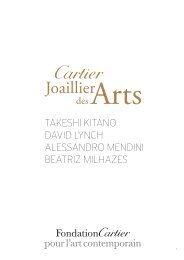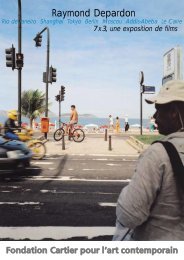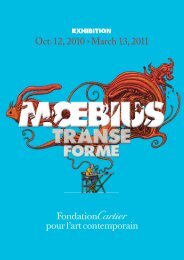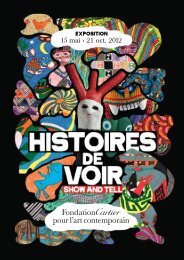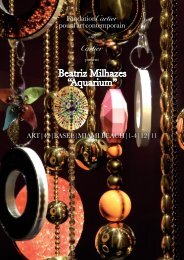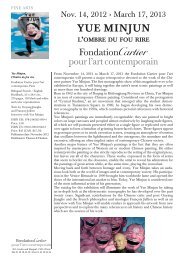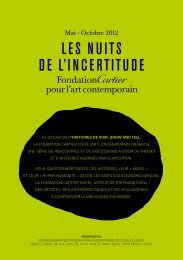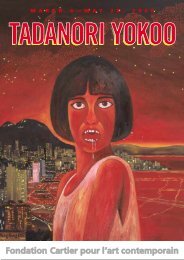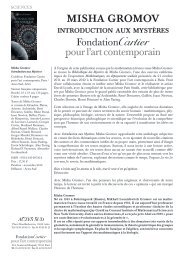Download - Fondation Cartier pour l'art contemporain - Cartier
Download - Fondation Cartier pour l'art contemporain - Cartier
Download - Fondation Cartier pour l'art contemporain - Cartier
Create successful ePaper yourself
Turn your PDF publications into a flip-book with our unique Google optimized e-Paper software.
RON MUECK<br />
NOVEMBER 19, 2005—FEBRUARY 19, 2006<br />
MEDIUM AND TECHNIQUE<br />
Ron Mueck’s sculptures captivate the viewer though their physical realism, from their<br />
poses to the minute details of their skin. Their magical appeal is the result of a lengthy, meticulous process that<br />
brings several factors into play: manifest talent, a precise knowledge of anatomy, and extraordinary technical<br />
savoir-faire. Ron Mueck either personally carries out or is closely involved in each step of the creative process<br />
in his studio. When making larger or multiple works, he sometimes requires the help of assistants.<br />
The artist begins by crafting a series of small plaster maquettes, a process that allows him<br />
the opportunity to study the possibilities for the figure’s position. When the pose is determined he makes<br />
decisions about scale, often making a series of drawings in different sizes before reaching a final conclusion.<br />
Next Mueck sculpts the figure in clay incorporating all the fine details of expression and skin texture that<br />
appear in the finished work. If the artist is making a very large figure, as in the case of In Bed, he first creates<br />
a metal armature which is then covered by wire mesh and swathed in plaster strips before being covered with<br />
modelling clay.<br />
When the clay sculpture is finished, a uniform coat of shellac is applied over the entire<br />
surface so that the clay will not dry out. A mould is then made of the sculpture using silicone, which captures<br />
all the details of expression and skin texture, supported by fiberglass to hold the shape. Sometimes it is<br />
necessary to construct the mould in sections so that it can be removed from the sculpture with greater ease.<br />
To fabricate the sculpture itself, Mueck first applies a layer of gel-coat which incorporates<br />
pigments on the interior of the mould, giving the skin color and depth. Depending on the size of the sculpture,<br />
the artist then paints layers of fiberglass or silicone into the mould until the required thickness and density are<br />
attained. Fiberglass is generally used for large scale works. It is much stronger and has the advantage over<br />
silicone that any seams still visible after the casting process can be filed and polished away. When using<br />
fiberglass, individual hairs are glued into holes that have been drilled by hand. Silicone is much softer and has<br />
the advantage that hairs can be individually punched into the surface, which looks more authentic. As a result<br />
the artist will often cast a silicone face for large fibreglass sculptures so that facial and head hair can be applied<br />
with greater ease.<br />
Removing the sculpture from the mould is not an easy process. Great care must be taken<br />
so that the silicone is not torn or stretched. Once removed, any seams are polished away and the artist will<br />
paint finer details such as veins and blemishes on the surface. Finally, the artist turns his attention to the eyes,<br />
which he sculpts himself and then puts into place, bringing his creation to life.<br />
5



